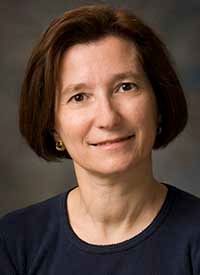Commentary
Article
Ongoing Research Aims to Address Further Questions on Fixed-Duration Therapy in CLL
Author(s):
Alessandra Ferrajoli, MD, discusses the continued investigation of fixed-duration therapy as a frontline approach for patients with CLL, highlights both the pros and cons of this strategy, and touches on the unanswered questions regarding fixed-duration therapy that ongoing research aims to address.
Alessandra Ferrajoli, MD

Although questions remain regarding the optimal duration of treatment and the use of prognostic factors to guide treatment decisions, frontline fixed-duration therapy could lower the safety and financial burden for patients with chronic lymphocytic leukemia (CLL), according to Alessandra Ferrajoli, MD.
“We are getting there. It is just a matter of time. Things are moving quickly, and within the next 2 to 3 years, we [could] have [more answers for fixed-duration therapy],” said Ferrajoli, who presented on fixed-duration therapy in CLL during the 2023 SOHO Annual Meeting.
In an interview with OncLive®, Ferrajoli discussed the continued investigation of fixed-duration therapy as a frontline approach for patients with CLL, highlighted both the pros and cons of this strategy, and touched on the unanswered questions regarding fixed-duration therapy that ongoing research aims to address. Ferrajoli is a professor in the Department of Leukemia, Division of Cancer Medicine at The University of Texas MD Anderson Cancer Center in Houston.
OncLive: What was the goal of your presentation on fixed-duration therapy in CLL at the 2023 SOHO Annual Meeting?
Ferrajoli: My goal was to discuss where we are at this time in making [fixed]-duration therapy a possibility for the majority of patients with CLL. I discussed the data we have available so far from phase 2 and phase 3 clinical studies with [fixed]-duration therapy. [These trials] are mostly based on either a combination of targeted therapy with a monoclonal antibody, or a combination of 2 targeted therapies with a monoclonal antibody.
While I reviewed those studies, I also pointed at the unanswered questions regarding [fixed]-duration therapy. Is it possible for everyone? What needs to be the duration? Should the duration be based on a time limit decided up-front? Or should duration be based [on] the patient’s prognostic factors? Should we base [the duration on] the degree of response, [referring to] measurement of residual disease as an end point? Should we base [duration] on the time to achieve response, [meaning] how quickly negativity for measurable residual disease is achieved? Or should [duration] be based on some novel prognostic factors? [These novel prognostic factors] may be very applicable to the design of the future [fixed]-duration therapies.
What data have supported the potential transition to fixed-duration therapy for patients with CLL?
We have very mature data from the [phase 3] CLL 14 study [NCT02242942] from the German [CLL Study] Group [that examined venetoclax (Venclexta) plus obinutuzumab (Gazyva) vs obinutuzumab plus chlorambucil]. We have fairly good, mature data from a phase 2 study [NCT02756897] that we performed at The University of Texas MD Anderson Cancer Center [evaluating venetoclax plus ibrutinib (Imbruvica)]. We also have [data from] some studies that used triplets, such as the [phase 2] BOVen trial [NCT03824483] that [examined zanubrutinib (Brukinsa), obinutuzumab, and venetoclax], and these studies also used at [fixed]-duration therapy.
What are some of the pros and cons of fixed-duration therapy compared with continuous therapy?
[Fixed]-duration therapy has mostly pros. First, no one wants to be on treatment forever. Second, toxicities, even if they are light, are going to be less relevant if [a patient] knows they are going to [eventually] discontinue that agent. I'm talking about mild toxicities, such as joint pain. If a patient knows they may to have joint pain for [approximately] 1 year, they may [tolerate it]. However, if you tell a patient they are going to have joint pain for the next 10 years, it's a different issue. The third important component is cost, because [fixed]-duration therapy is cheaper. There are a lot more biological aspects [when considering fixed-duration therapy]. For example, maybe [fixed-duration therapies] will induce less resistance, or they may improve the immune system, which can then pick up on its own.
However, there are some cons [to fixed-duration therapy]. One—which is something I've experienced with my patients—is anxiety. When [a patient] discontinues a therapy, you start monitoring [for relapse], and every visit [will include the questions] of whether the report will be good. With [continuous] treatment until progression, [patients] expect more visits to have good reports because they know they are still receiving the agent.
Second, we don't know whether there will be less resistance with [fixed]-duration therapy. Maybe there will be less resistance if we keep pressure on the disease. Particularly for patients who have adverse prognostic factors, such as patients with 17p deletions or complex karyotypes, we don't have a lot of strong data on large patient groups in the frontline, since these patients are rare in the frontline setting. For those patients, I am more hesitant to say that results are optimal for [fixed]-duration therapy.
For patients with CLL receiving fixed-duration therapy, how do you monitor these patients after they complete treatment? Does it differ from patients receiving continuous therapy?
All my patients on fixed-duration [therapy] have been on clinical trials, so the monitoring is dependent on the [design of the] clinical trial. However, I would say that the standard is to monitor every 3 to 6 months. I don't recall anyone we monitored with intervals that were longer than 6 months. We may start at 3 months right after treatment discontinuation, and then once you have a little more experience with a particular patient, you could extend it to 6 months.
Reference
Ferrajoli A. Is finite duration the new standard of therapy in frontline CLL? Presented at: 2023 SOHO Annual Meeting; September 6-9, 2023; Houston, TX.








